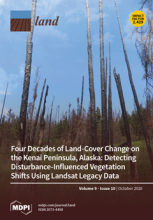Land Library
Welcome to the Land Portal Library. Explore our vast collection of open-access resources (over 74,000) including reports, journal articles, research papers, peer-reviewed publications, legal documents, videos and much more.
/ library resources
Showing items 19 through 27 of 47.Forests managed by Indigenous and other local communities generate important benefits for livelihood, and contribute to regional and global biodiversity and carbon sequestration goals. Yet, challenges to community forestry remain.
Rapid expansion of unsustainable farming practices in upland areas of Southeast Asia threatens food security and the environment. This study assessed alternative agroforestry systems for sustainable land management and livelihood improvement in northwest Vietnam.
Non-indigenous conifers are considered invasive to the coastal dune heathland in Denmark, and massive clearing is carried out in an attempt to recreate and keep the original heathland.
With growing global demand for food, unsustainable farming practices and large greenhouse gas emissions, farming systems need to sequester more carbon than they emit, while also increasing productivity and food production.
Knowledge transfer depends on the motivations of the target users. A case study of the intention of Indonesian coffee farmers to use a tree canopy trimming technique in pine–based agroforestry highlights path-dependency and complexity of social-ecological relationships.
Mountainous regions are more sensitive to climatic condition changes and are susceptible to recent increases in temperature. Due to urbanization and land use/land cover (LULC) issues, Cameron Highlands has been impacted by rising land surface temperature (LST) variation.
In recent years modern societies have attached a multifunctional requirement to the use of renewable resources, making their optimal sustainable management more complex.
Papua New Guinea is a country in Oceania that hosts unique rain forests and forest ecosystems which are crucial for sequestering atmospheric carbon, conserving biodiversity, supporting the livelihood of indigenous people, and underpinning the timber market of the country.
Agroforestry, as the dominant land use at the volcanic foot slope in Java Island, is prone to landslide due to a combination of rough relief and thick soil layer.



